


Go to:
Siena ~
Montepulciano ~
Chiusi ~
Pienza ~
Montalcino ~
San Quirico d'Orcia ~
Bagno Vignoni ~
Radicofani ~
San Gimignano ~
Colle Val d'Elsa ~
Monteriggioni ~
San Galgano Abbey ~
Asciano ~
Monte Oliveto Maggiore ~
Panicale ~
Castiglione del Lago ~
Città della Pieve ~
Cortona
Siena

Our itinerary of this splendid medieval city is along the main street of the city.
Visiting the St. Dominican church an important testimony to gothic architecture, but whose fame is tied to, above all, the presence of relics of St. Catherine of Siena, patron of the city. Following the main street you will have the possibility to see (externally) the seat of the celebrated Monte dei Paschi di Siena Bank, then finally arriving at the Cathedral, a Sienese gothic architectural masterpiece containing extraordinary sculptures, such as the Pulpit by Nicola Pisano (1268) and some sculptures by Michelangelo, realized for the tomb of cardinal Francesco Piccolomini, the future Pope Pius III.
The entrance fee to the cathedral is 3.00Euro a person and 6.00Euro for the period when the pavement is uncovered (from 18th August to 29th October). The tour finishes in the Campo Square, one of the most beautiful and suggestive squares in Italy, rich in monuments and a spectacular venue for the Siena Palio.
The Cathedral Museum contains important paintings and Sienese works of art for the most part from the Cathedral. The most celebrated work of the museum is the Maestà by Duccio di Boninsegna. Among the other painters, the Museum has on show works by Pietro Lorenzetti, Jacopo della Quercia, Sano di Pietro, numerous sacred vestments, relics, liturgical silver and sculptures by Giovanni Pisano which adorned the facade of the Cathedral.
The National Art Gallery, housed in the Brigidi and Buonsignori Palaces, is characterized, above all, by its extraordinary collections of panel paintings with a 'gold background' from the thirteenth and fourteenth century by such masters as Duccio di Buoninsegna, the Lorenzettis, Simone Martini, Sassetta. Also notable for the quality and quantity are the later works, by such great painters as Francesco di Giorgio, Matteo di Giovanni, Sodoma and Beccafumi.
Museum of the Santa Maria della Scala Hospital. This was once a great hospital and today has become a great museum, where it is possible to visit more than 40,000sq.mt. of monumental areas such as the Pilgrim Hostel, the Mantle Chapel, the Old Sacristy and Saint Catherinès Night Oratory, all decorated with works by the great Sienese artists of various eras. As well, inside the interesting tunnels, is present the Archeological Museum. Given its dimensions it is a 'city within the city'.
Town Hall Civic Museum. The visit to the palace allows one to see the ancient rooms used by the mayor and all the public employees of the city in the course of the centuries: the rooms are decorated by beautiful works of art such as the great Maestà frescoed by Simone Martini, also the celebrated fresco of Guidoriccio da Fogliano, the frescos of Good and Bad Government by Ambrogio Lorenzetti and the frescos by Beccafumi in the salon of the Consistory.
The Contrada Museums. It is possible to visit the seat of one of the contradas of the city however it must be booked in advance and the cost varies according to which contrada is visited.
Siena, paid bus parking.
For information you can contact the Siena Parking on 0577-228711 or by e-mail at si.park@sienaparcheggi.com or have a look at www.sienaparcheggi.com
NOTE: there is no parking fee for the bus if the group books a visit to the Town Hall Museum or the Santa Maria della Scala Museum.
La Val di Chiana
Montepulciano
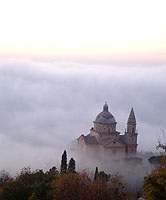
The itinerary starts at the Tempio of S. Biagio; a true masterpiece of Renaissance architecture realized by the architect Antonio da Sangallo the Elder, which is found just outside the city. The tour continues with a visit to the historical centre of Montepulciano. The Piazza Grande has a nucleus of the most important monuments, surrounded by such buildings as: the Cathedral, which contains a beautiful triptych by the Sienese painter Taddeo di Bartolo, an altar by Andrea della Robbia and a funeral monument sculptured by the Florentine architect and sculptor Michelozzo; the Town Hall, the Contucci Palace and the Nobili-Tarugi Palace. The visit follows with a walk along the main street of the town rich in Renaissance buildings. Recommended during the itinerary is a stop at the city's Cellars. Montepulciano is in fact celebrated for its Vino Nobile di Montepulciano and in the historical centre still exist in historic buildings, the Cellars within that can be visited free of charge, for a little taste (also this is free) of the celebrated wine. This visit is always recommended as the cellars are all very beautiful and of great architectural interest.
Crociani Art Gallery and Civic Museum. The Civic Museum possesses a beautiful collection of archeological finds from the Etruscan and Roman eras, a rich collection of terracotta pieces by Andrea Della Robbia and numerous paintings from 1200 to 1800. Recently discovered a portrait of a man that has been attributed to Caravaggio.
Chiusi
Named by its founders Clevsin, Chiusi was one of the most important Etruscan cities in the history of this mysterious population whose maximum splendour was between the VII and the V century B.C., during which time also reigned the celebrated king Porsenna who besieged (and perhaps conquered) Rome. It became a Roman city in the 1st century B.C. with the name Clusium. The centre of the city conserves few traces of the Etruscan buildings, but there are numerous objects which have been found in the necropolis of the city, today conserved in the Archeological Museum. Chiusi had a new urban development in the early Christian and Medieval eras. Of note to see is the beautiful San Secondiano Cathedral, one of the most ancient in Tuscany, which, even though restored in the 1800's, still conserves the basilica layout with columns recovered from the Roman era. Instead the false mosaic paintings that decorate the interior are from the 19th century. Also interesting is a walk in the small historical centre of the city which conserves both medieval buildings and those of a later period.
During the visit it is always advisable to add an entrance to one of the following museums:
National Archeological Museum. The museum, recently renovated, conserves more than two thousand objects from the prehistoric, Etruscan (which are in the majority), Roman and Longobardic periods, found in Chiusi and the surrounding area. The entrance ticket to the Museum also includes a visit to two Etruscan tombs which are found a few kilometers outside Chiusi and can be reached by bus.
Civic Museum - The underground city. The museum possess a vast collection of lapidary material exhibited in a long route of more than 140metres of underground tunnels excavated in the Etruscan era and from which can be seen a lake 30 metres under the road, which is fed by rain water.
The Labyrinth of Porsenna. It is an underground route around 120 metres long that forms a type of aqueduct and that finishes in a large cistern from the 1st century B.C. of the Roman era. From here the return to the surface is by entering the Cathedral's bell tower from the top of which you can admire a panorama of the Valdichiana.
The Catacombs of St. Catherine and St. Mustiola. The two catacombs are found around 3 kilometres outside the historical centre. It is best to book the visit beforehand at the Cathedral Museum.
La Val d'Orcia
Pienza
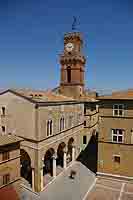
Pienza was constructed by Pope Pius II and is the first example of an 'Ideal City' realized in the Renaissance, starting with the reconstruction of the ancient medieval hamlet of Corsignano in which the Pope was born in 1405. Bernardo Gambarelli called Rossellino was the architect who succeed in less than four years, between 1459 and 1462, to transform the dream of the Pope into a reality.
The guided visit to the city includes the Cathedral and the St. Francis Church with the Renaissance cloister annex, plus a visit of the entire main street along which face the principal Renaissance buildings. As well at visit to some of the very fascinating little streets, such as the via della Fortuna, dell'Amore and the via Case Nuove, the first examples of working-class houses as created by Pope Pius II for those who lost their medieval houses during the building of Pienza. The streets are without monuments, but charming for their beauty. In 1996 Pienza was declared a UNESCO World Heritage Site.
Piccolomini Palace Museum. This was the residence of Pope Pius II and inside it is conserved the furnishings of the family Piccolomini from the time of Pius II until the recent era. Therès a beautiful loggia which looks over the hanging garden and the Renaissance style courtyard.
Diocesan Museum. The museum conserves a rich collection of paintings by celebrated artists such as Pietro Lorenzetti, Vecchietta, Luca Signorelli, FràBartolomeo, as well as silver objects, sculptures and tapestries. Among the most precious pieces of the collection, is the celebrated Pius II Cope, sewn by hand in silk and gold.
Montalcino - The Abbey of Sant'Antimo

Montalcino is a medieval hamlet built on a hill that dominates the Val d'Orcia, and which has become celebrated for its beauty, but above all, for its wine which is one of the most famous in the world, the Brunello di Montalcino. The most important monument in the city is the thirteenth century Fortress, today the seat of the principal events of the city such as the Thrush Feast and the Honey Fair. The visit includes all the streets of the medieval hamlet rich in history and of the buildings both religious and civil. The most beautiful and important religious building of Montalcino, without a doubt, is found outside the town about 10 kilometres is the Abbey of Sant'Antimo near Castelnuovo dell'Abate.
The Abbey was founded, according to legend, by Charlemagne in 781 and entrusted to the Benedictine monks. The church has remained intact over time, while the major part of the buildings which made up the abbey complex have been lost. The church, isolated among olive trees that are more than hundred year old, in a valley rich in cypresses and vines, is one of the best examples of Romanesque architecture conserved in Tuscany and today looked after by a few monks called the Regular Canons who had have reintroduced the ancient use of the Gregorian Chant during the religious functions.
 The times in which it is possible to hear the Gregorian Chant are: morning: 8.45am -12.45pm; afternoon 14.45pm and 7.00pm plus Sundays when it is possible to hear it during the 11am Mass.
The times in which it is possible to hear the Gregorian Chant are: morning: 8.45am -12.45pm; afternoon 14.45pm and 7.00pm plus Sundays when it is possible to hear it during the 11am Mass.
Civic and Diocesan Museum. The Museum has a collection of the principal works of art that decorated churches and palaces in the territory. Works by the important Sienese painters are found, above all from the 1300 to 1400 up to 1600 and beyond, with works by painters such as Luca Tommè, Bartolo di Fredi, Sano di Pietro plus examples of ceramics and liturgical silver. Recently an archaeological section has been added with Etruscan finds from the territory of Montalcino
San Quirico d'Orcia
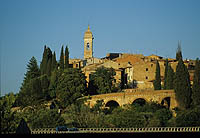
The medieval hamlet of San Quirico d'Orcia is found on the Via Francigena (Pilgrim's way) whose development was helped by the passing of numerous pilgrims. Its principal monuments are the Romanesque and Gothic Collegiate inside which is conserved, among other works of art, the altarpiece by Sano di Pietro; the Chigi Palace, built for cardinal Flavio Chigi by Carlo Fontana at the end of the seventeenth century and today the seat of the Municipal offices; the Horti Leonini, a splendid Renaissance garden situated near the city walls, and seat for the summer exhibition of contemporary sculpture.
Bagno Vignoni

The little hamlet of Bagno Vignoni has been a noted spa resort since the Roman era which today conserves some medieval and renaissance buildings. The inhabited area is characterized by the presence in its centre of a large pool with a spring of thermal water that flows at a temperature of 52°C and whose curative properties favoured long holidays for many illustrious personalities, such as Lorenzo dè Medici and Pope Pius II.
Radicofani

Radicofani is a small medieval town built on the top of a hill of the same name on which is erected an imposing medieval Fortress in which sheltered, at the end of 1200's the bandit Ghino di Tacco. Recently restored, the Fortress merits a visit (entrance fee) to admire it all (there are remains from the medieval era to the 1500s) and to see the beautiful panorama over the Val d'Orcia.
The small town has two Church originally Romanesque (later renewals), the St. Agatha Church and that of St. Peter in which it is possible to admire the splendid glazed terracotta sculptures by Andrea della Robbia and his school.
The Val d'Elsa
San Gimignano
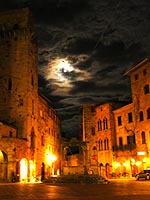
San Gimignano is one of the most celebrated medieval towns in the Siena province. San Gimignano is the city of Towers, but also the home of the Vernaccia di San Gimignano wine, a great D.O.C.G. white wine. It is a city rich in splendid monuments, with an extraordinary, well conserved, historical centre. The itinerary starts from the St. John's Gate from which is accessed the first half of the town's main street which leads to the stage setting Cistern Square, so called because of the presence of a thirteenth century cistern. From this we enter the Cathedral Square where we find the Cathedral, inside decorated with an extraordinary cycle of medieval frescos of the Story of the Old and New Testament, the work of Bartolo di Fredi and the workshop of Memmi, plus other fifteenth century frescos by Benozzo Gozzoli and the splendid Santa Fina Chapel frescoed in 1468 by Domenico Ghirlandaio. The entrance to the Cathedral is by payment: a ticket for a group is 3.00Euro a person (1.50Euro for students). In the Cathedral square there is the Town Hall, with its beautiful courtyard, seat of the Civic Museum. And so to the celebrated Towers: in the square there are the two highest towers of the city, that of the Municipality called the Great Tower and that of the Podestà Palace called the Scabby Tower. The tour continues following the second half of the main street, via San Matteo, finishing at the St. Augustine Church, a great medieval building inside of which is conserved works of art such as the cycle of frescos of the life of St. Augustine painted by Benozzo Gozzoli and the beautiful altarpiece representing the Coronation of the Virgin by Piero del Pollaiolo. The visit can be concluded by a climb up the Rocca (Fortress) from which can be admired a splendid panorama of the city.
The Civic Museum in the Town Hall is where you can admire, the Maestà by Lippo Memmi in the Dante Salon, as well as a series of panels and canvases by artists such as Benozzo Gozzoli, Filippino Lippi, Taddeo di Bartolo and Pinturicchio. It is possible to climb the Great Tower.
San Gimignano 1300. In this museum is presented the history of the city through reproductions of San Gimignano in miniature, as it was in the XIV century, the period of the city's greatest splendour. All the works on show have been realized totally by hand.
San Gimignano, paid bus parking.
For information have a look at www.comune.sangimignano.si.it
NOTE: there are discounts for the bus parking if the group books a visit to one of the Civic Museums of the city or a hotel or a restaurant.
Colle Val d'Elsa
Colle Val d'Elsa is an ancient city originally Etruscan developed in the medieval period on three levels: the lower part called the Flat where today is the seat of the modern part of the city and where the famous Crystal factories are found that produce objects in crystal sold all over the world; an intermediate part called the Castle and the upper part called St. Catherinès Hamlet. This ancient subdivision has been simplified by the distinction between Lower Colle and Upper Colle. Upper Colle is the older part and rich in monuments of which there is a visit to admire the Sapia bastion, the Campana Palace, a splendid fifteenth century building, via delle Volte, a long vaulted tunnel that is among the more particular streets of the city, the Cathedral, dedicated to Saints Albert and Martial, where inside there is a beautiful fourteenth century pulpit, the relic of the Sacred Nail and numerous pictorial works of art. Plus it's worth to see the Arnolfo Tower, a medieval tower in which, according to legend, the celebrated sculptor and architect Arnolfo di Cambio was born, one of the most distinguished inhabitants of the city.
Colle Val d'Elsa is also rich for its museums. To be remembered are the following museums: Sacred Art Museum. The museum conserves a precious collection of panels with gold backgrounds among the most outstanding are the Maestà by Maestro di Badia a Isola and a wooden polychrome Crucifix from the end of the XIII century by Marco Romano. Among the other works are a Madonna and Child by Segna di Bonaventura, and that of Pier Francesco Fiorentino. Also present are works by the local artist Cennino Cenninie, artists from the sixteenth and seventeenth centuries among whom are Alessandro Casolani, Ventura Salimbeni, Bernardino Mei, Pier Dandini. Of importance is Galognano's Treasure, a very rare Eucharistic vestment in silver from the VI century.
The Ranuccio Bianchi Bandinelli Archaeological Museum. The museum has on show Etruscan finds coming from the Colle Val d'Elsa territory and Monteriggioni, among which is the reconstructed face of an Etruscan girl from 2,500 years ago, carried out by the Pisa University.
The Crystal Museum. The Museum is built in the lower part of Colle Val d'Elsa and consists of various sections that illustrate the making process of the crystal, the materials, the instruments used to produce it and as well has a large exhibition of objects which give a precise idea of the production of these objects for which the city of Colle has been the leader for a long time.
With a booking it is also possible to visit one of the Crystal factories and be present during the manufacturing by one of the firms of the city.
Monteriggioni
The Castle of Monteriggioni, even though reduced in size, is one of the most beautiful and particular hamlets in the Siena province, characterized by a medieval wall of 570metres with 14 towers, all perfectly conserved. This castle was well known and cited by Dante in the XXXI Inferno Canto. It was purposely constructed by the Sienese between 1214 and 1219 for defense. Its small historical centre does not have any particular monuments, but the fascination of this small hamlet is extraordinary. Part of the walkway along the walls is visible and from which can be admired the splendid Chianti countryside and a particular view enjoyed of the hamlet and its fortifications.
La Val di Merse
The San Galgano Abbey and Monte Siepi Hermitage
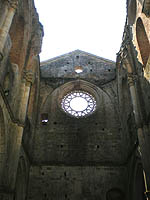
The San Galgano Abbey is one of the most beautiful pieces of gothic architecture of Tuscany. Constructed by the Cistercian monks during the 1200's, near to the Romanesque Monte Siepi Hermitage, where Saint Galgano lived and to whom the Abbey is dedicated, and which today is a place of great fascination. The abbey complex was one abandoned and was almost completely lost. There remains principally the extraordinary gothic church; a particularity of it is the total lack of the floor, where exists a mantle of grass and of the ceiling: the sky is the ceiling of this unique church. On foot you can reach the Monte Siepi hermitage, a rare circular shape of the Romanesque church, where San Galgano's famous 'sword in the rock' is conserved. The visits to the church is by payment of 1.50Euro a person for groups of more than 20 people (for less than 20 people entrance is 2.00Euro a person) .
Val d'Arbia and the Crete Senesi
Asciano
Asciano is a medieval city (but the area was first inhabited by the Etruscans and then the Romans) and is found in the area of the Crete Sienese, to be more precise in the Valle dell'Arbia, where one of its more well known products is the Crete Pecorino Cheese. Among the religious buildings of merit to visit is the thirteenth-fourteenth century Collegiate Church of St. Agata, the St. Augustine Church (originally medieval, but restored in the XVII century), the Grain Square with the beautiful fourteenth century fountain by Antonio di Paolo Ghini and the Podestà Palace and all the Matteotti main street rich with beautiful palaces from various periods.
Cassioli Museum. It is a museum dedicated to the Asciano painter Amos Cassioli (Asciano 1832- Firenze 1891) where there are also conserved works by other Sienese painters from the 1800's such as Angelo Visconti, Pietro Aldi, Giuseppe Mussini and Giuseppe Cassioli, giving life to this unique museum in the province of Siena dedicated to Sienese painters from the XIX century.
Civic Archeological and Sacred Art Museum. Its seat is in the thirteenth century Corboli Palace where there is a collection of important Sienese painting and ceramics. Among the works is a wooden Crucifix by Giovanni Pisano, a Madonna and Child by Segna di Bonaventura, the extraordinary Triptych of Rofeno by Ambrogio Lorenzetti, the beautiful Nativity of the Virgin by Maestro dell'Osservanza and other later paintings such as the beautiful Crucifixion by Bernardino Mei.
Monte Oliveto Maggiore

Placed on a hill and surrounded by a square kilometre of wood, rises the Monte Oliveto Maggiore Abbey, founded by Saint Bernardo Tolomei at the beginning of the 1300s. Inside the Abbey you visit the church (reconstructed in the XVII century) where you can admire the splendid inlayed wooden choir stalls from the beginning of the 1500s by Frà Giovanni da Verona, the fourteenth century cloister, decorated with a beautiful cycle of frescos of the life of St. Benedict painted by Luca Signorelli (at the end of 1400s) and Sodoma (at the beginning of 1500s), you can also see the refectory and library, the last architectural work of Frà Giovanni da Verona.
Places outside the province of Siena
Panicale
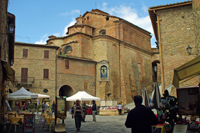
Panicale is an Historical and picturesque hamlet in the Province of Perugia, built on top of an hill of 441 metres of elevation. The origin is Medieval and most of the building date back that period. Panicale is one of the "Borghi più belli d'Italia" (most beautiful hamlets of Italy) and it has the "Orange Flag" a recognition of the quality of the tourist services of this place. Inside the village is worth to see the church of S. Michele Arcangelo and first of all the church of S. Sebastian where we can admire the famous fresco by Pietro Perugino "The Martyrdom of S. Sebastiano" (entrance fee) and the Madonna and Angels anther fresco attributed to Raffaello. Very small but beautiful is also the Caporali Theatre that dates back to the 19th Century (entrance fee).
Castiglione del Lago
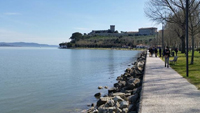
The little village of Castiglione del Lago is enclosed by the Medieval walls. There is a beautiful Medieval Castle (The Lion Castle), good example of a Medieval military construction built in the middle of the 1200 with a pentagonal plan, five towers and three gates, with the main tower that has an elevation of thirty metres. Another important building is the Della Corgna Palace built by the famous Capitain Ascanio della Corgna and connected by a long corridor to the Castle. Inside (entrance fee that includes the visit at the Palace and the Castle) there are all the rooms decorated with frescoes mainly by Nicclò Circignani called the Pomarancio and Savio Savini, representing Mythological scenes and the feats of Ascanio. The main church of the village is S. Maria Maddalena, realized in the middle of the 19th Century with an interesting painting by a pupil of Perugino. Absolutely charming is the village with so many little shops where we can spend our free time.
Città della Pieve

Città Della Pieve is a charming little Medieval town that underwent many changes over the Centuries, especially during the 18th Century and it is famous to be the town where was born the very famous artist Pietro Vannucci called Perugino, the master of Raffaello. The all town is built in bricks and this give to the town a particular aspect with many little alleys among which the most famous is the Vicolo Baciadonne that is one of the most narrow in all Italy. Beautiful it is also the main square with the Cathedral of Saint Gervasio and Protasio that houses two paintings by Perugino and the Della Corgna Palace built for the will of the great capitain Ascanio della Corgna. Interesting to see also the Oratory of the Whites (entrance fee) that preserves the beautiful fresco by Perugino The adoration of the Magi.
Cortona

Cortona has an Etruscan origin and a part of its city wall is still Etruscan The center of Cortona has a medieval origin but many buildings were remade over the Centuries. In Cortona you find an incredible passage from one age to another. You start from the Bifora Gate, that is Etruscan, you walk in via Jannelly, Medieval and then you reach in few minutes the Cathedral which is summary of different ages, from the Middle Age to the 19th Century. Then there are the two main squares, Piazza Signorelli with the Casali Palace that houses today the MAEC Museum with a beautiful collection of Etruscan objects, Painting of different ages, sculptures and even an Egyptian collection of Mummies (entrance fee), and Piazza della Repubblica with the Town Hall. Another monument to see is the church of Saint Francis built by Elia Coppi, the Franciscan friar who led the Franciscan Order after the death of S. Francis. Very charming is Via Nazionale, the main street of the town so reach of shops and good café that ends in Garibaldi Square with a great view on the Trasimeno Lake. You can rich finally the Santa Margherita Sanctuary by car or by bus, just few kilometres outside Cortona, a beautiful church with a great view on the Chiana Valley.





